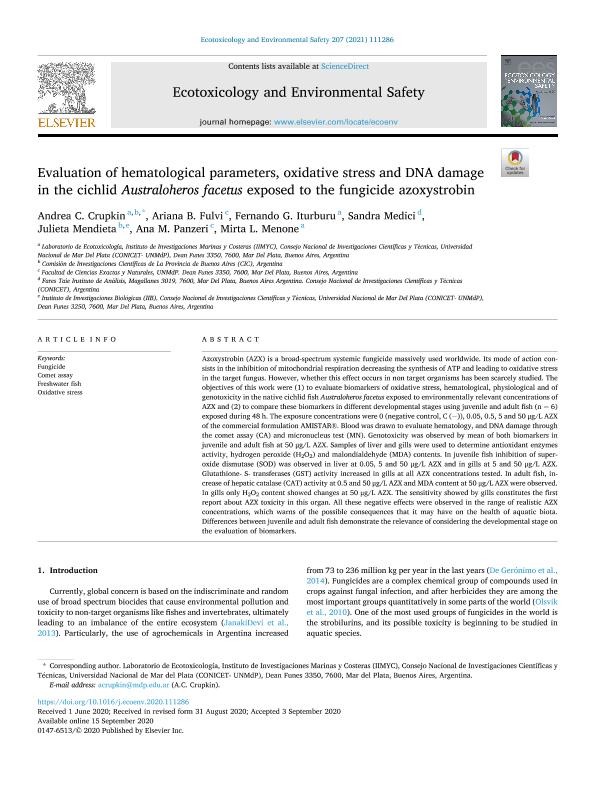Artículo
Evaluation of hematological parameters, oxidative stress and DNA damage in the cichlid Australoheros facetus exposed to the fungicide azoxystrobin
Crupkin, Andrea Carina ; Fulvi, Ariana Berenise; Iturburu, Fernando Gastón
; Fulvi, Ariana Berenise; Iturburu, Fernando Gastón ; Medici, Sandra Karina
; Medici, Sandra Karina ; Mendieta, Julieta Renee
; Mendieta, Julieta Renee ; Panzeri, Ana María; Menone, Mirta Lujan
; Panzeri, Ana María; Menone, Mirta Lujan
 ; Fulvi, Ariana Berenise; Iturburu, Fernando Gastón
; Fulvi, Ariana Berenise; Iturburu, Fernando Gastón ; Medici, Sandra Karina
; Medici, Sandra Karina ; Mendieta, Julieta Renee
; Mendieta, Julieta Renee ; Panzeri, Ana María; Menone, Mirta Lujan
; Panzeri, Ana María; Menone, Mirta Lujan
Fecha de publicación:
09/2020
Editorial:
Academic Press Inc Elsevier Science
Revista:
Ecotoxicology and Environmental Safety
ISSN:
0147-6513
Idioma:
Inglés
Tipo de recurso:
Artículo publicado
Clasificación temática:
Resumen
Azoxystrobin (AZX) is a broad-spectrum systemic fungicide massively used worldwide. Its mode of action consists in the inhibition of mitochondrial respiration decreasing the synthesis of ATP and leading to oxidative stress in the target fungus. However, whether this effect occurs in non target organisms has been scarcely studied. Theobjectives of this work were (1) to evaluate biomarkers of oxidative stress, hematological, physiological and ofgenotoxicity in the native cichlid fish Australoheros facetus exposed to environmentally relevant concentrations of AZX and (2) to compare these biomarkers in different developmental stages using juvenile and adult fish (n = 6)exposed during 48 h. The exposure concentrations were 0 (negative control, C ( )), 0.05, 0.5, 5 and 50 μg/L AZX of the commercial formulation AMISTAR®. Blood was drawn to evaluate hematology, and DNA damage through the comet assay (CA) and micronucleus test (MN). Genotoxicity was observed by mean of both biomarkers in juvenile and adult fish at 50 μg/L AZX. Samples of liver and gills were used to determine antioxidant enzymes activity, hydrogen peroxide (H2O2) and malondialdehyde (MDA) contents. In juvenile fish inhibition of superoxide dismutase (SOD) was observed in liver at 0.05, 5 and 50 μg/L AZX and in gills at 5 and 50 μg/L AZX. Glutathione- S- transferases (GST) activity increased in gills at all AZX concentrations tested. In adult fish, increaseof hepatic catalase (CAT) activity at 0.5 and 50 μg/L AZX and MDA content at 50 μg/L AZX were observed. In gills only H2O2 content showed changes at 50 μg/L AZX. The sensitivity showed by gills constitutes the first report about AZX toxicity in this organ. All these negative effects were observed in the range of realistic AZX concentrations, which warns of the possible consequences that it may have on the health of aquatic biota. Differences between juvenile and adult fish demonstrate the relevance of considering the developmental stage on the evaluation of biomarkers.
Palabras clave:
FUNGICIDE
,
COMET ASSAY
,
FRESHWATER FISH
,
OXIDATIVE STRESS
Archivos asociados
Licencia
Identificadores
Colecciones
Articulos(CCT - MAR DEL PLATA)
Articulos de CTRO.CIENTIFICO TECNOL.CONICET - MAR DEL PLATA
Articulos de CTRO.CIENTIFICO TECNOL.CONICET - MAR DEL PLATA
Articulos(IIMYC)
Articulos de INSTITUTO DE INVESTIGACIONES MARINAS Y COSTERAS
Articulos de INSTITUTO DE INVESTIGACIONES MARINAS Y COSTERAS
Citación
Crupkin, Andrea Carina; Fulvi, Ariana Berenise; Iturburu, Fernando Gastón; Medici, Sandra Karina; Mendieta, Julieta Renee; et al.; Evaluation of hematological parameters, oxidative stress and DNA damage in the cichlid Australoheros facetus exposed to the fungicide azoxystrobin; Academic Press Inc Elsevier Science; Ecotoxicology and Environmental Safety; 207; 9-2020
Compartir
Altmétricas



